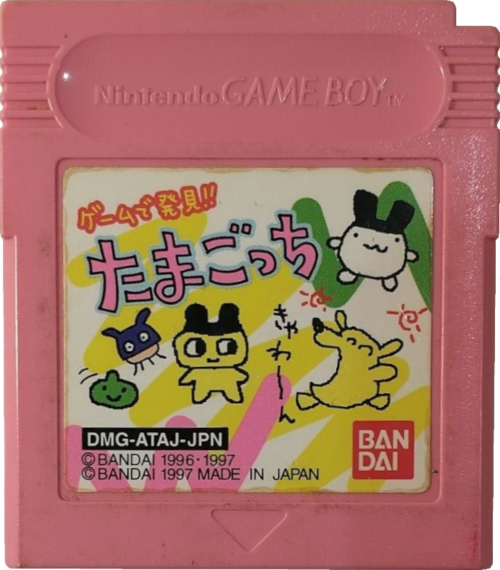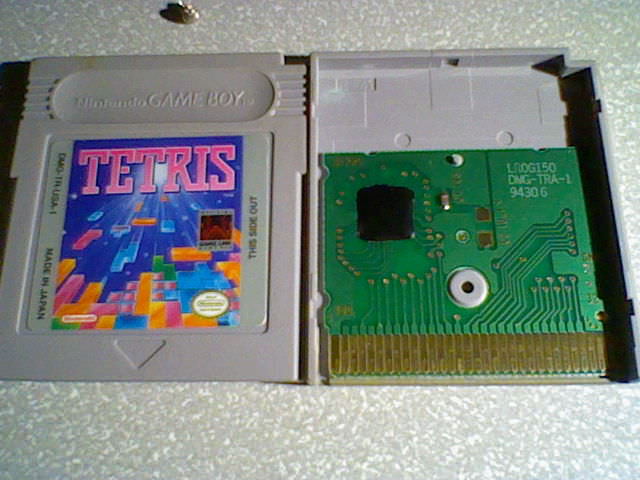Opening a cart is the best way to verify a cart. However, you can verify that a game is genuine or fake without opening carts. Pokemon games can differ, so there is a separate section especially.
Verifying DMG games
Label
- Cart label art will not be the same as the box art. What's the best way to find your game's proper label art? Google.
Label should have a factory imprint on it, like two numbers or a number and a letter. These fade over time though but labels can easily be replaced, however a die stamp kit can be used to recreate these. YMMV. - Some DMG games will also have grey borders on the left and right sides with the game's serial code and region written on them. Some games don't have grey borders, like Alleyway.
- Mainly for US games - The ESRB of "E for Everyone" varies. Around the time of the DMG/GBC era, ESRB revised their logos so earlier games will have the old logo and newer games have the newer logo. Popular examples of games that changed ESRB logos in between prints area Pokemon Red, Blue, and Yellow.
 |
| Don't worry too much about the ESRB logo. Back in the DMG/GBC era, ESRB revised their logos. Gen 1 Pokemon games are one of the most popular games that were "in print" when ESRB made the switch. Old logo or not, it's not a red flag for bootlegs. |
- Low resolution, home-printed label. A very easy, noticeable trait of fake carts.
- The code printed on the label being incorrect, if the code is even there. For example, here's a Pokemon Gold cart, with the code on the label relating to Pokemon Silver.
 |
| Another dead givaway is the code printed on the label (if it's even there) being wrong. From my experience, plenty of other factors will have been glaringly obvious already at the point so this wouldn't be necessary. This cart is the only one that I've encountered where I've needed to check. This cart initially threw me for a loop but between the code being wrong and one other easily missable thing, it was pretty obvious it was bootleg. |
Cart
- If the cart says "GAME" instead of "Nintendo GAME BOY™", it's a guaranteed bootleg.
 |
| Faker than Kim K's arse. |
- Check the "Nintendo GAME BOY™" on the top/grip part.
 |
| Most people know that if it says "GAME" on top, it's bootleg. What most people don't know is that just because it says "NintendoGAMEBOYTM", it doesn't immediately mean it's authentic. These two are pretty convincing at first but it looks really bad the longer you examine them. Remember that Nintendo's logo should be thin horizontally and thick vertically. |
- The Nintendo logo has never changed fonts since the 70's. Nintendo's logo is supposed to be thick vertically while thin horizontally.
- If the font looks like it's consistent in its thickness, if the "t" looks like it has a tail like a "j", if anything looks off even with just a single letter, that's a red flag.
- Do note that the "e" is kinda weird. I've seen a few pics and vids of carts that have a different looking "e" but are verified authentic.
- The "GAME BOY" part should be thinner than the Nintendo logo. It should also be somewhat italicized. It should be more of a "GAME BOY" as opposed to just "GAME BOY".
- The "TM" should be the smallest and the thinnest
- All of these should be all aligned at the bottom. If one is raised higher than than the others, that's a red flag.
- Other moldings include the down arrow at the bottom of the cart which is often too deep on most bootlegs.
Notes
- This was an era when Nintendo used to off-load some manufacturing to others, like Tetris for example.
- Verified authentic carts with the Nintendo logo on the grip isn't necessarily 1:1 with Nintendo's actual logo.
- Just looking up different variations of the game Alleyway shows as much.
- No one singular characteristic qualifies your cart as authentic, nor does one single element disqualify it.
Verifying Pokemon games
Pokemon games have noticeable differences compared to other Game Boy games, hence the different section.
Generation 1 - Red, Green, Blue, Yellow
Label
- The label art should never be just the box art. If yours has "GAME BOY" written vertically next to Blastoise, it's counterfeit.
- Mainly for US games - The ESRB of "E for Everyone" varies. Around the time of the DMG/GBC era, ESRB revised their logos so earlier games will have the old logo and newer games have the newer logo.
- The old logo looks like a mist of dots in the outline of an "E" so don't be concerned if this is what you have. It's most likely just an earlier print.
Cart Colours
- This is the biggest giveaway. They're the only coloured DMG carts (unless they're Japanese regional variants).
- If your Pokemon cart is grey or black, it's a guaranteed bootleg.
Other Factors
- Pokemon Green was NEVER released outside of Japan. If your green isn't Japanese in a grey cart, it's fake.
- You should still be following the DMG information.
- Be suspicious of seller listings for full sets or cheap items. Pokemon carts are amongst the most pirated games due to their popularity.
Generation 2 - Gold, Silver
Label
- The labels for Gen 2 games should have a metallic effect, not glossy. Think hollow/foil trading cards.
- Label should have a factory imprint on it, like two numbers or a number and a letter. These can fade over time though.
Cart Colours and Translucency
- Gold and Silver should be Gold and Silver respectively with glitters on them.
Other Factors
- You should still be following the DMG information for Gold and Silver.
- Be suspicious of seller listings for full sets or cheap items. Pokemon carts are amongst the most pirated games due to their popularity.
Footnotes
- Legitimate Nintendo OEM games that were released in the Hong Kong or China regions may have also had the black epoxy blob. These carts might be extremely rare (from the region, not with a blob).
Cartridge Colour Depository
Contrary to popular belief, there are many different colours of DMG cartridges. This section serves as a depository for authentic DMG carts. In some cases, different variants are also available. These will be marked with an asterisk (*).
The DMG was released in an era where Nintendo did not "code" every model of cartridge. As a result, some columns may be marked as non-applicable (N/A).
Please right-click (or tap and hold the image down), and "Open Image in New Tab" for higher resolution.
| No. |
Description |
Colour |
Code |
Front |
Back |
| 1. |
Regular Cartridge |
Grey |
DMG-09 |
 |
 |
| 2. |
Pokemon Blue |
Blue |
DMG-09 |
 |
 |
| 3. |
Pokemon Gold |
Gold |
DMG-09 |
 |
 |
| 4. |
Pokemon Gold (JP) |
Blue and Dark Grey |
DMG-09 |
 |
 |
| 5. |
Pokemon Pinball |
Black |
DMG-13 |
 |
 |
| 6. |
Pokemon Pinball (JP) |
Yellow and Black |
DMG-13 |
 |
 |
| 7. |
Pokemon Red |
Red |
DMG-09 |
 |
 |
| 8. |
Pokemon Silver |
Silver |
DMG-09 |
 |
 |
| 9. |
Pokemon Silver (JP) |
Grey and Blue |
DMG-09 |
 |
 |
| 10. |
Pokemon Trading Card Game |
Black |
DMG-09 |
 |
 |
| 11*. |
Pokemon Yellow |
Yellow |
DMG-09 |
 |
 |
| 12*. |
Tamagotchi |
Pink |
DMG-09 |
 |
 |
| 13*. |
Tamagotchi |
White |
DMG-09 |
 |
 |
| 14. |
Tamagotchi Male and Female |
Blue |
N/A |
 |
 |
| 15. |
Game Boy Camera |
Blue |
MGB-006 |
 |
 |
| 16. |
Game Boy Camera |
Clear Purple |
MGB-006 |
 |
 |
| 17. |
Game Boy Camera |
Green |
MGB-006 |
 |
 |
| 18. |
Game Boy Camera |
Red |
MGB-006 |
 |
 |
| 19. |
Game Boy Camera |
Yellow |
MGB-006 |
 |
 |
| 20. |
Game Boy Pocket Sonar |
Teal |
N/A |
 |
 |
| 21*. |
Rev 1 AGB Development Cart |
Black |
N/A |
 |
 |
Different Variants
| No. |
Variant(s) |
Further Notes |
| 11 |
The Donkey Kong Land series and Tamagotchi 2 were also released using this colour cartridge. |
N/A |
| 12 |
Tamagotchi was also released in a white cartridge. |
The pink variant of Tamagotchi was released as a limited edition, in Japan only. |
| 13 |
Tamagotchi was also released in a pink cartridge. |
The white variant of Tamagotchi was released as the standard edition, in Japan only. |
| 21 |
Whilst using the DMG casing, these Rev 1 AGB Development Carts were used for the development of the Game Boy Advance. |
The 64Mb cartridges have E201629 on the front label. |
Credits
- Special thanks to SeanOrtiz for writing this guide, and giving us permission to use.



















































